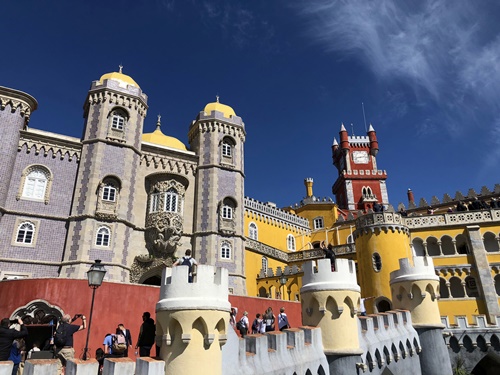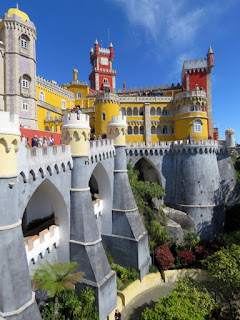Sintra - Palace and Park of Pena
We visited Sintra on 4 May 2018. It was the most beautiful day of our trip of Lisbon and the surroundings. Gorgeously blue sky with mild temperature, colourful and world heritage Palace and Park of Pena, Moorish Castle (Castelo dos Mouros), Palace National of Sintra ............
Our apartment is located at Bairro Alto. The easiest is to hop to Rossio Station to take a train to reach Sintra. Between 7 and 10 am, the train is very frequent, every 15 minutes. Half of them takes 40 minutes and the rest 49 minutes. Afterwards, the train departs every 20 minutes. Since the bus from Sintra railway station to the Palace of Pena starts to get long early, it's better to start the trip early. It's steep to walk up to the Palace of Pena. The best is to take bus 434, €6.9 for return.
 Queues for bus and the ticket for the Pena Palace are long. So, be patient. After getting off the bus, one has to climb a bit to reach the ticket office of the Palace of Pena. We were stunned by the colourful palace while walking up the short slope up. It stands admirably top of the hill. Indeed, it is the focal point when we were in Sintra. It can be seen from the park of the palace, the Moorish Castle and everywhere. Even when we were in Sebutal and Cristo Rei, we could barely see it.
Queues for bus and the ticket for the Pena Palace are long. So, be patient. After getting off the bus, one has to climb a bit to reach the ticket office of the Palace of Pena. We were stunned by the colourful palace while walking up the short slope up. It stands admirably top of the hill. Indeed, it is the focal point when we were in Sintra. It can be seen from the park of the palace, the Moorish Castle and everywhere. Even when we were in Sebutal and Cristo Rei, we could barely see it.
The Romantic Palace Pena originated as a chapel built on top of the hill in Sintra and dedicated to the Lady of Pene in the Middle Ages. At the end of 15th century, King Manuel I ordered the construction of a monastery on this site. It remained very small and could accommodate 18 monks at a maximum. After the earthquake in 1755, the monastery became a ruin. Until 1838, King Ferdinand acquired the monastery and lands in the surroundings to transform it to a palace for the royal families as a summer residence.
After the king's death, the palace was passed to his second wife Countess of Edla. It was sold to King Luis and subsequently to the Portuguese State. Palace Pena was classified as a national monument and transformed into a museum after the Republican Revolution of 1910.
The different vivid colours and very different architectural elements draw every visitors' admiration. The most mysterious is the Arch of the Triton. A mythological monster, half-man and half-fish is squatting between the aquatic world below and the terrestrial world above. This decorative art may be King Ferdinand's attempt to recover features of the Portuguese culture. The Triton is mentioned by Damião Góis (philosopher) and Luís de Camões (poet).
Apart from the Arch of Triton, there are other special architectural and decorative elements. As Portugal was ruled by the Moorish, lots of related features are present. One room in the palace is called Arabic Room.
Some pieces of sculpture are funny. They look like dwarfs with angry faces and yell to the air. Some are elegant such as a big shell basin on the courtyard at the ground floor. Underneath is decorated with turtles.
Rooms in the palace are similar to other palaces. But the decorative arts are special and many are oriental, both Chinese and Japanese. Perhaps, the king was very proud of the acquisition of Macau and as the first foreign country landing in Japan. Among all the rooms, my favourite is the kitchen. Utensils are immense. They rarely appear in the modern society. Forms of cake pan are very special: piggy, dolphin, castle, etc.
Visitors can have great views of the surroundings from both outside and inside the palace. The most spectacular is the Moorish Castle nearby. There are other beautiful buildings which are probably private and not featured in touristic articles. The position of the palace certainly allows you to capture exceptional panoramic views of Sintra.
At age 24, opera singer Elisa Hensler met Ferdinard II after her performance in Lisbon. They fell in love and travelled in Europe together. After their marriage in 1869, Hensler was awarded the title of Countess of Edla. They built a chalet and magnificent garden near a dramatic series of granite rocks with a view of the palace and sea. After the death of Ferdinard II, the palace and the surroundings were acquired by the State while the countess could use the chalet and garden. Visit to the interior of the chalet requires an extra ticket.
After the king's death, the palace was passed to his second wife Countess of Edla. It was sold to King Luis and subsequently to the Portuguese State. Palace Pena was classified as a national monument and transformed into a museum after the Republican Revolution of 1910.
The different vivid colours and very different architectural elements draw every visitors' admiration. The most mysterious is the Arch of the Triton. A mythological monster, half-man and half-fish is squatting between the aquatic world below and the terrestrial world above. This decorative art may be King Ferdinand's attempt to recover features of the Portuguese culture. The Triton is mentioned by Damião Góis (philosopher) and Luís de Camões (poet).
Apart from the Arch of Triton, there are other special architectural and decorative elements. As Portugal was ruled by the Moorish, lots of related features are present. One room in the palace is called Arabic Room.
Rooms in the palace are similar to other palaces. But the decorative arts are special and many are oriental, both Chinese and Japanese. Perhaps, the king was very proud of the acquisition of Macau and as the first foreign country landing in Japan. Among all the rooms, my favourite is the kitchen. Utensils are immense. They rarely appear in the modern society. Forms of cake pan are very special: piggy, dolphin, castle, etc.
Visitors can have great views of the surroundings from both outside and inside the palace. The most spectacular is the Moorish Castle nearby. There are other beautiful buildings which are probably private and not featured in touristic articles. The position of the palace certainly allows you to capture exceptional panoramic views of Sintra.
At age 24, opera singer Elisa Hensler met Ferdinard II after her performance in Lisbon. They fell in love and travelled in Europe together. After their marriage in 1869, Hensler was awarded the title of Countess of Edla. They built a chalet and magnificent garden near a dramatic series of granite rocks with a view of the palace and sea. After the death of Ferdinard II, the palace and the surroundings were acquired by the State while the countess could use the chalet and garden. Visit to the interior of the chalet requires an extra ticket.
Near the Chalet of Countess of Edla stands a Gardener's House. Only the windows and door beam are decorated with cork, closely resembling the chalet. It is a one-room house for the storage of gardener's tools and as a shelter against rain and coldness evidence by the presence of a fireplace.
Walk further south we reached the stable. It is rather quiet. Next is a little farm. Goats enjoyed the shelter and present climate.
Going further down towards the exit is the beautiful, lush green and romantic Valley of the Lakes.






























Comments